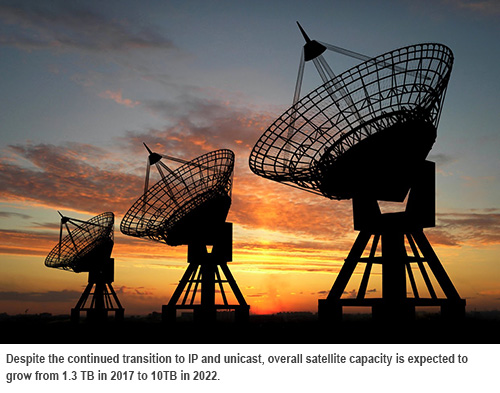Satellite Broadcast Market Update
by Elisabeth Tweedie
Los Angeles, Calif., April 1, 2019--In an article for this publication exactly a year ago, I suggested that maybe it was time for us to start thinking of ourselves as the bandwidth industry, rather than the satellite industry. Now, I’m not vain enough to think that that remark was what prompted DirecTV to announce at the end of last year that it would not be ordering any more satellites, and that it would instead concentrate on building out fiber and OTT offerings for its customers.
Nevertheless, it is a very interesting move on the part of one of the major satellite video players in the US. However, to put this in perspective, it should be remembered that the last two satellites launched for DirecTV will be in service until 2030 at least, so this will not be a sudden withdrawal from satellite delivered video. Findings from Leichtman Research Group indicate that during 2018, DirectTV lost 1.236 million subscribers. During the same time period, the relatively new IP offering known as DirectTV Now gained 436,000 subscribers, making a total of around 1.6 million subscribers. DirectTV is far from unique in losing subscribers: Dish TV also lost over 1 million subscribers last year, and its IP offering Sling TV gained 205,000 subscribers, bringing the total to 2.417 million subscribers.
 Direct to Home (DTH) is not alone in losing subscribers; in the US the major cable companies and phone companies also lost over 1 million TV subscribers the last year. Given that between them, they have over 56 million subscribers compared to DTH’s 29 million, this is obviously a much smaller percentage. However, these terrestrial companies also provide Internet and phone service, and frequently they are the only provider of Internet service in any given area. This adds a degree of “stickiness” which, in spite of the major improvements in satellite broadband in recent years, satellite operators find hard to compete with.
Direct to Home (DTH) is not alone in losing subscribers; in the US the major cable companies and phone companies also lost over 1 million TV subscribers the last year. Given that between them, they have over 56 million subscribers compared to DTH’s 29 million, this is obviously a much smaller percentage. However, these terrestrial companies also provide Internet and phone service, and frequently they are the only provider of Internet service in any given area. This adds a degree of “stickiness” which, in spite of the major improvements in satellite broadband in recent years, satellite operators find hard to compete with.
As we all know, these statistics do not mean that people are watching less video. If anything, people are spending more time watching video, but are consuming it in different ways. According to IHS Markit the number of subscriptions to online video services worldwide increased to 613.3 million in 2018, up 131.2 million from 2017. Cable subscriptions fell 2% to 556 million. According to the study, most households subscribe to both cable and OTT and are therefore counted in both categories.
The OTT market, although growing rapidly, is still dominated by Netflix, Amazon Prime and Hulu. But there are no shortage of competitors, “wannabe” competitors, and market exiters. On the same day, that Apple announced Apple TV+; according to Bloomberg, YouTube cancelled plans to build a slate of high-end programming. Thereby shifting away from its premium subscription service. Given that Goldman Sachs estimates that Netflix’s 2018 content spend could be as high as US$ 13 billion, it would take steely nerves and deep pockets to want to compete with that. Apple apparently has both.
However, although the announcement came with a great deal of fanfare, it did not come with a great deal of detail. What we do know, is that it will launch in over 100 countries this fall. Different TV channels will be offered including HBO, Showtime and Starz as well as Apple’s own channel showing original content produced by Apple. Pricing was not announced, but customers will apparently be able to select which channels they want and pay for only those. Disney will also launch its own streaming service later this year. Unlike Apple, which is a newbie in the content production business, Disney has a vast catalog and will make it available in its entirety for its streaming service. It’s currently in the process of pulling its content from Netflix. Obviously, Disney has a more precisely targeted audience than Netflix, but given the size and timelessness, of its content library, which appeals to children now as much as it did to those of 20 years ago, this is a streaming service that could well be a great success.
Netflix, meanwhile continues to go from strength to strength. At the end of Q3 last year, Netflix had 137.1 million users. 57% of which come from outside the US. 23 languages are supported. In the US Netflix has a 51% share of the paid streaming market, Amazon Prime is in second place with a 33% share. In the UK, the ratio is similar, 59% Netflix, 31% Amazon Prime. Interestingly in the UK last year, the number of subscribers to streaming services actually overtook number of people who use traditional satellite or cable television services, [15.4 Million to 15.1 Million].
So, what does this continued transition to IP and unicast mean for satellite? Is it the beginning of the end, as some are saying, or is there still a role for satellite in an IP world? During World Satellite Business Week last September in Paris, Euroconsult forecasted a slight increase in video capacity leased to 2021 but a decline in revenue, from ~US$ 7 Billion today to ~US$ 6 Billion in 2021. However, overall satellite capacity is expected to grow from 1.3 TB in 2017 to 10TB in 2022.
Concurrent with the move to unicast streaming services, is the move to higher quality video, from standard definition [SD], to high definition [HD] and now to ultra high definition [UHD], otherwise known as 4K, all of which require increasing amounts of bandwidth. UHD has not been as fast to take off as many people have expected. However, as Thomas Wrede, VP New Technologies & Standards, SES Video, points out: its introduction is actually moving at a faster pace than that of HD. Two years after its introduction there were 32 HD channels, whereas in the same time period there were 92 UHD channels.
Higher bandwidth requirements and more viewers can create bottlenecks for terrestrial services. These can occur in two areas. Locally, the amount of bandwidth available to each individual home in an area tends to decrease during high viewing and occupancy times. This can cause buffering issues in the evenings or on weekends when the majority of households will have one or more occupants on the computer and/or watching streaming video. The other bottleneck occurs during major events, often live sporting events when the playout servers simply cannot handle number of video streams requested. As we all know, neither of these cause any problems when satellite is used to multicast video.
Various approaches, targeted at different parts of the value chain, are being offered to keep satellites relevant and capitalize on its high bandwidth, multicast efficiencies. One approach from Broadpeak, known as nano-CDN uses adaptive bit rate streaming (ABR) over satellite, to transform the unicast OTT video stream to multicast at the headend, for delivery over the network. At the home it is transformed back into a unicast stream for viewing on WiFi connected devices. This is the approach adopted by Eutelsat in its Cirrus service.
An alternative, but similar approach, is that adopted by Anevia and Quadrille who have partnered to deliver OTT over satellite. The solution enables content providers and operators to offer live-TV services in situations where it was previously unavailable due to limited bandwidth. The OTT Stream is delivered via satellite, and at the receiving end, the signal is re-transformed to enable Multi-screen viewing on any smart device. Initial applications are targeted at high-speed trains, in-flight entertainment and universities.
On the contribution side, Eutelsat and The Switch are partnering to provide what they call ”An unparalleled satellite and fiber video contribution network.” The partnership utilizes three Eutelsat satellites covering Europe, Africa and the Americas with The Switch’s global video transport network. Keith Buckley, president and CEO of the switch, said: “We have seen a huge increase in the demand for worldwide uplinking, from our connected customers and venues. Partnering with Eutelsat, allows us to combine our shared resources to bring a seamless, flexible offering to market.”
Seamless and flexible. Those two words probably sum up, what is needed. Given the growing, but changing OTT market, satellite operators need to be flexible to accommodate the changing needs of their customers, and willing to continue innovating to provide a seamless service with terrestrial networks.
------------------------------
 Elisabeth Tweedie has over 20 years experience at the cutting edge of new commmunications entertainment technologies. She is the founder and President of Definitive Direction (www.definitivedirection.com), a consultancy that focuses on researching and evaluating the long-term potential for new ventures, initiating their development, and identifying and developing appropriate alliances. During her 10 years at Hughes Electronics, she worked on every acquisition and new business that the company considered during her time there. She can be reached at etweedie@definitivedirection.com.
Elisabeth Tweedie has over 20 years experience at the cutting edge of new commmunications entertainment technologies. She is the founder and President of Definitive Direction (www.definitivedirection.com), a consultancy that focuses on researching and evaluating the long-term potential for new ventures, initiating their development, and identifying and developing appropriate alliances. During her 10 years at Hughes Electronics, she worked on every acquisition and new business that the company considered during her time there. She can be reached at etweedie@definitivedirection.com.





